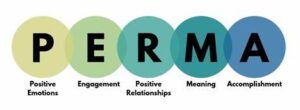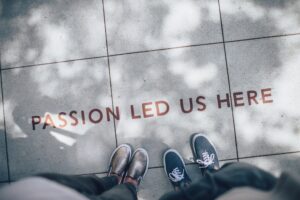Unlocking Your Pathway to Engagement and Productivity
Rory was completely dialed in, hands working expertly as she sanded the detailed edges of the bookshelf. The noise of the workshop faded as she focused intently on the precision required. Hours passed unnoticed as she finished sanding and began staining the wood. Suddenly, the alarm she’d set on her phone broke her deep concentration. She sat back, stretched her shoulders, and realized it was nearly midnight. But instead of fatigue, she felt energized and accomplished after becoming so absorbed in her woodworking project. Those hours spent in complete immersion were the most satisfying moments of her favorite hobby. That’s the power of flow.
We have all experienced flow at time in our lives. For many of us it probably seems fleeting, even happenstance, but often desired because of its immersive nature. Fortunately, flow can be cultivated, especially when you understand the mechanisms that underlie flow.
The concept of flow originated in the 1970s from the research of pioneering psychologist Mihaly Csikszentmihalyi. As a professor at the University of Chicago, his curiosity was piqued by artists who would become so immersed in painting that they would disregard their need for food, water, and even sleep. What enabled such intense focus and drive?
Csikszentmihalyi interviewed numerous creative people and athletes across diverse fields about their best performances. Despite their varied activities, they described remarkably similar experiences of being “in the zone” – fully engaged, challenged, and performing at their peak. Csikszentmihalyi developed the term “flow” to describe this euphoric state of optimal experience.
While fleeting in nature, these flow states can have profound impacts on productivity, creativity, learning, skill development, and overall well-being. The more we understand the characteristics and conditions enabling flow, the more effectively we can structure our days to spend more time immersed in these magical zones of being our best selves.
Understanding the Flow State of Mind
There are several hallmark signs indicating when someone has entered an elusive state of flow:
- Complete focus – Their attention is firmly anchored in the present moment on the task at hand. No distractions can interfere.
- Loss of self-consciousness – They are too engaged to worry about outside perceptions or self-criticism.
- Distorted sense of time – The immersive experience alters their time perception. Hours can pass like minutes.
- Intrinsic motivation – The activity itself becomes rewarding beyond any external goals or rewards.
- Balance of challenge and skills – There is an ideal match between the difficulty of the task and their ability to accomplish it.
While the specific activities leading to flow may differ between individuals, these core characteristics remain constant. For example, athletes may experience flow while on the court or field playing their game. It is one of those times when the commentator says, “he is unconscious out there” and everything looks effortless. Despite the diversity of these talents and tasks, the subjective flow state shares common neural correlates in the brain, marked by heightened activation of reward and motivation circuits. Understanding how to tap into this optimal zone at will holds the key to more joy, productivity, and personal growth in life.
Cultivating the Conditions for Flow
Certain steps can be taken to intentionally set the stage for those magical and coveted flow states:
- Identify your personal flow triggers – What types of activities result in your complete focus and immersion? Reflect on times when you’ve felt “in the zone” and aim to do those activities more often.
- Set clear goals and expectations – Having well-defined objectives and steps to achieve them helps set the stage for flow to occur.
- Minimize distractions and interruptions – Protect your time for flow by turning off phones, closing email, finding quiet spaces. Reduce disruptions.
- Track progress and make adjustments – Regularly assess what’s working versus not working in your process to optimize activities for flow.
- Practice mindfulness – Train your mind to avoid distractions, reduce wandering thoughts, and keep bringing yourself back to the present moment.
- Achieve balance between boredom and anxiety – Flow happens when challenge is balanced with skills. Move out of your comfort zone carefully.
- Focus on intrinsic rewards – Seek activities that are rewarding for their own sake, not just external goals. Find joy in the process.
There are many examples of activities conducive to flow in common domains like sports, hobbies, work, and learning. For instance:
- Athletes may experience flow while training for a marathon or competing in a tournament.
- Musicians can achieve flow while improvising new music or mastering a complex piece (but not learning a new piece).
- Painters and artists may enter flow during the creative process, losing track of time.
- Surgeons can attain flow while performing challenging operations requiring intense concentration.
- Computer programmers may find flow when debugging complex code or developing algorithms.
- Writers can achieve flow while organizing ideas or developing scenes for a novel.
- Students may enter flow when practicing challenging material that stretches their abilities.
The key is taking time for reflection to identify those activities that seem to lift you into the flow state. Then structure your days to regularly engage in those optimal flow triggers. Make self-care and stress management priorities as well, since burnout and excessive anxiety can sabotage flow.
Harnessing the Benefits of Flow States
Why devote time and effort to cultivating more flow experiences? What benefits can we expect to see?
Decades of research on flow suggests numerous positive outcomes in those who experience flow more frequently:
- Increased productivity and performance – By completely concentrating efforts on the task at hand, more gets accomplished in less time. Studies of workers indicate they are happier and more productive on days with more flow.
- Heightened creativity – New insights and ideas often emerge when people are fully immersed in an activity. Flow seems to spark creativity.
- Faster skill development – The intensity of concentration during flow accelerates learning and mastery compared to more diffuse attention.
- Greater self-esteem – The immersive experiences provide a sense of success and self-efficacy, building confidence.
- Reduced anxiety and depression – Flow activities can act as an escape from rumination and provide uplifting engagement and meaning.
- Overall life satisfaction – More frequent flow experiences correlate to greater well-being, happiness, and life satisfaction according to studies.
- Brain benefits – Flow states seem to boost motivation and learning circuits in the brain, enhancing neural connections.
Simply put, activities that induce flow make you feel more engaged, energized, and fulfilled. They provide gratifying challenges to build your abilities while offering feelings of joy and control.
Flow essentially means learning to live more fully in the present, rather than dwelling on the past or worrying about the future. You develop an ability to appreciate each challenge before you, lose yourself in intrinsically-rewarding activities, and find fulfillment in the experience itself, beyond external measures of success or failure.
Capturing More Flow
While the moments of flow may come and go, you can implement strategies to capture those magical moments more frequently:
- Identify your personal flow triggers – Pay attention to the types of activities that seem to unlock your greatest capacities for focus and engagement. Seek out more opportunities to engage in your flow triggers.
- Create rituals and routines – Build regular flow practicing into your schedule, whether it’s morning pages for writers or evening jogs for runners. Ritualize flow.
- Optimize your environment – Remove clutter or disruptions from your space. Create a flow-friendly space tailored to your chosen activities.
- Set SMART goals – Set specific, measurable goals with attainable steps to create the right level of challenge to stretch your skills.
- Track progress mindfully – Periodically record your progress and reflect on areas for adjustment while staying focused on the present.
- Absorb intrinsic rewards – Rather than focus on extrinsic rewards like money or acclaim, connect to the inherent joy and satisfaction of the activity itself.
- Balance stressors – Manage anxiety and take care of your mental and physical health to prevent burnout which can impede flow.
- Strengthen concentration – Practice mindfulness meditation to enhance focus and train your mind to minimize distractions.
- Adjust difficulty – Seek challenges at the edge of your abilities, stepping further past your comfort zone to match skills and demands. Consider tools like gaming sites that automatically adjust difficulty in response to performance.
Pay attention to when you feel happiest and most engaged in activities that provide that sense of optimal experience. Then structure your life to spend more time immersed in those flow-inducing zones. Keep pushing your abilities through smart goal setting and progress tracking to balance your skills with increasing challenges.
Make the commitment to unlock your greatest potentials through the flow state. Let time fade away so you can emerge energized, empowered, and rewarded by the experience rather than drained. The more frequently you can access this complete engagement, the more you will accomplish and progress.
The pathway to flow exists within you – discover it. The rewards are waiting if you make the effort to open yourself to possibility and flow.
Great Things Never Came From Comfort Zones
Say goodbye to that rut you’ve been stuck in and hello to a brighter future with enLiven Wellness Life Coaching team. Get started today by scheduling a consultation with our team.
Related Resources
enLiven Wellness Coaching, llc is a participant in the Amazon Services LLC Associates Program, an affiliate advertising program designed to provide a means for website owners to earn advertising fees by advertising and linking to amazon.com, audible.com, and any other website that may be affiliated with Amazon Service LLC Associates Program. As an Amazon Associate [I or we] earn from qualifying purchases.
Additional Articles in this Series
This article is part of a series of articles on the five pillars of well-being. The pillars are positive emotion, engagement, relationship, meaning, and accomplishment.

















